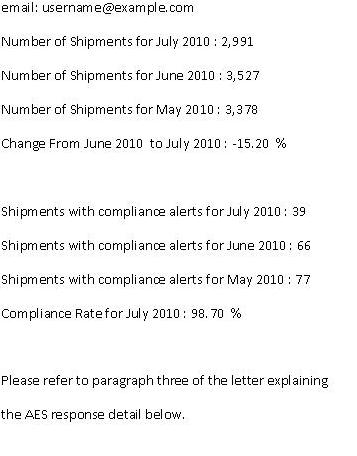
An official website of the United States government
Here’s how you know
Official websites use .gov
A .gov website belongs to an official government organization in the United States.
Secure .gov websites use HTTPS
A lock (
) or https:// means you’ve safely connected to the .gov website. Share sensitive information only on official, secure websites.
-
//
- Census.gov /
- Newsroom /
- Census Blogs /
- Global Reach /
- Understanding Your Compliance Report — Part 1
Understanding Your Compliance Report — Part 1
Understanding Your Compliance Report — Part 1
As I have written on this blog previously, the Automated Export System Branch (AESB) has various tools for companies to ensure that their filing practices are in compliance with the Foreign Trade Regulations (FTR). One of the most important tools is the compliance report.
The report is sent on a monthly basis via e-mail to your company’s account administrator. The e-mail includes a message explaining the purpose of the report and how you can analyze it. The specific shipments filed and the compliance rate for your company are detailed in the text attachment that’s included with the e-mail.


The AESB considers a 95% compliance rate or above as satisfactory. If your company has a compliance rate less than 95%, it’s considered unacceptable and the AESB will work with your company to achieve an acceptable compliance rate. The AESB will assist in determining what could be causing the low rates. For example, it’s possible that shipments are being filed with the incorrect departure dates. Compliance rates can also be affected if your company is adding commodity lines to a shipment after the departure date. Your organization needs to verify the information, take action in resolving the issues that generate a low compliance rate and work with the AESB on how to improve that rate.
The AESB has developed the AES Best Practice Manual. This manual provides a variety of best practices that have been compiled as a result of visits to companies with an acceptable compliance rate of over 95%. Utilizing some of the best practices found in this manual can assist and ensure that your company achieves and maintains a 95% compliance rate or above, as well as to maintain compliance with the FTR.
Share
 Yes
Yes
 No
NoComments or suggestions?


Top
